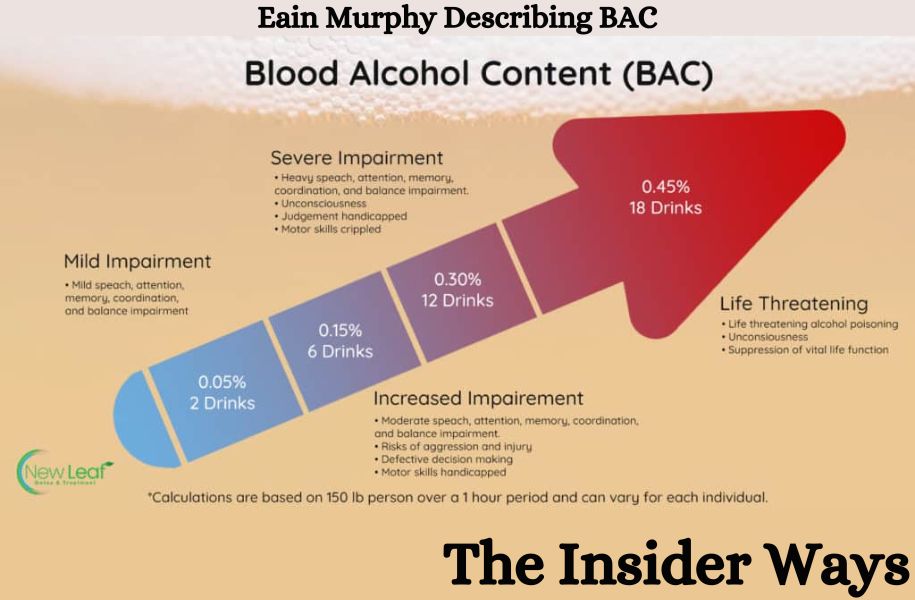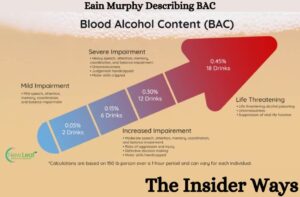In this article, “Eain Murphy Describing BAC,” we’ll delve into the importance and science behind Blood Alcohol Concentration (BAC) to understand its implications on health and safety. Eain Murphy, a noted health and safety advocate, provides valuable insights into BAC’s effects on the human body, shedding light on why awareness of BAC is critical for making safe, responsible choices when consuming alcohol. As we explore “Eain Murphy Describing BAC,” this article from The Insider Ways will provide a comprehensive understanding of BAC, the factors influencing it, and how it can vary across different individuals.
What is Blood Alcohol Concentration? – Eain Murphy Describing BAC
Blood Alcohol Concentration, commonly referred to as BAC, represents the amount of Alcohol present in a person’s bloodstream. BAC is expressed as a percentage, such as 0.08%, which would mean that there are 0.08 grams of alcohol for every 100 milliliters of blood. Eain Murphy emphasizes the importance of understanding BAC, as it is the most direct measure of intoxication and impairment. BAC levels are often used legally, socially, and medically to determine a person’s capability to perform certain tasks, such as driving or operating machinery.
As “Eain Murphy Describing BAC” explains, BAC can be affected by various factors including body weight, metabolism, gender, and rate of alcohol consumption. This critical measure of alcohol influence is especially relevant in the realm of public safety, where legal BAC limits play a central role in reducing accidents related to alcohol consumption.
Key Factors Affecting BAC – Insights by Eain Murphy
In “Eain Murphy Describing BAC,” Murphy discusses several primary factors that influence a person’s BAC. Understanding these factors is crucial in determining how alcohol impacts the individual.
- Body Weight and Size
Individuals with a higher body weight or larger body size generally experience lower BAC levels after consuming the same amount of alcohol as smaller individuals. Larger bodies have more water content, which helps to dilute the alcohol concentration in the bloodstream. Eain Murphy points out that this variability in BAC can significantly impact how two people may feel after drinking the same amount. - Gender Differences
Studies show that women typically reach higher BAC levels than men after consuming the same amount of alcohol. This difference, as Murphy explains, is due to body composition and hormonal factors. Women usually have a higher percentage of body fat and a lower amount of water than men, leading to less dilution of alcohol in the bloodstream, resulting in a higher BAC for women. - Rate of Alcohol Consumption
Eain Murphy highlights that the speed at which alcohol is consumed significantly affects BAC. Drinking large amounts quickly can overwhelm the liver, which metabolizes alcohol at a relatively fixed rate, causing BAC levels to rise rapidly. Slow, moderate drinking allows the liver to process alcohol more efficiently, leading to lower BAC levels. - Food Intake and Nutrition
Eating food before or while drinking can slow down alcohol absorption, as food in the stomach acts as a buffer. Eain Murphy describes how drinking on an empty stomach leads to quicker alcohol absorption into the bloodstream, resulting in a faster and higher BAC.
Effects of BAC Levels on the Body – Eain Murphy Describing BAC
Eain Murphy goes into detail about how varying BAC levels affect the body and the mind. Understanding these effects is crucial for making informed decisions regarding alcohol consumption, as they outline clear consequences of exceeding certain BAC thresholds.
- Low BAC (0.02% – 0.05%)
At a BAC between 0.02% and 0.05%, individuals may feel mildly relaxed, with a slight elevation in mood. However, as “Eain Murphy Describing BAC” outlines, there is already a slight impairment in decision-making abilities, and the individual’s ability to multitask may begin to decrease. - Moderate BAC (0.05% – 0.08%)
BAC levels in this range bring noticeable impairments in motor skills, coordination, and reaction time. Murphy emphasizes that this is the threshold at which driving or operating machinery becomes unsafe and illegal in many regions, as these tasks require precise coordination and quick reflexes. - High BAC (0.08% – 0.15%)
At BAC levels between 0.08% and 0.15%, significant impairments occur, including loss of balance, slurred speech, and a marked decrease in motor function. This level of intoxication can lead to poor judgment and risky behavior, increasing the likelihood of accidents or injuries. - Very High BAC (0.15% and Above)
According to “Eain Murphy Describing BAC,” very high BAC levels, especially those above 0.20%, can lead to extreme disorientation, nausea, and even loss of consciousness. Beyond 0.30%, individuals are at risk of life-threatening conditions like alcohol poisoning, which can lead to coma or death.
Legal and Safety Implications of BAC – Eain Murphy Describing BAC
BAC plays a significant role in legal contexts, particularly in relation to driving under the influence (DUI) laws. The Insider Ways brings attention to Eain Murphy’s observations on how BAC limits are enforced to promote public safety.
- Legal BAC Limits
Eain Murphy highlights the importance of legal BAC limits, which are set to reduce alcohol-related accidents. In many countries, a BAC of 0.08% is the legal limit for operating a vehicle. Exceeding this limit is considered unsafe and can lead to penalties, fines, or even jail time. - Field Sobriety Tests and Breathalyzers
Law enforcement often uses field sobriety tests or breathalyzer devices to determine a driver’s BAC. “Eain Murphy Describing BAC” notes that these tests are essential tools for keeping roads safer, as they prevent intoxicated individuals from putting themselves and others in danger. - Health and Safety Risks
In addition to legal consequences, Murphy points out the health risks associated with high BAC. The risk of accidents, injuries, and health complications increases as BAC rises. “Eain Murphy Describing BAC” emphasizes that even at lower levels, impairment can lead to risky situations.
Why Knowing BAC Matters – Eain Murphy Describing BAC
Understanding BAC is a critical step in promoting health and safety. The Insider Ways supports Eain Murphy’s advocacy for BAC awareness, particularly when it comes to personal and public health.
- Informed Decision-Making
By understanding how BAC levels impact the body and mind, individuals can make more responsible choices regarding alcohol consumption. As “Eain Murphy Describing BAC” suggests, knowing one’s limits and the effects of alcohol helps prevent overindulgence and its negative consequences. - Public Health and Awareness
Educating people on BAC and its effects promotes public health by reducing alcohol-related injuries and fatalities. “Eain Murphy Describing BAC” also highlights the need for awareness campaigns and educational efforts to reduce impaired driving and alcohol abuse. - Personal Responsibility and Safety
Eain Murphy stresses the importance of personal responsibility in managing alcohol consumption. This includes setting personal limits, knowing when to stop, and arranging for safe transportation if impaired.
Conclusion – Eain Murphy Describing BAC for Health and Safety
“Eain Murphy Describing BAC” offers a thorough understanding of Blood Alcohol Concentration, underscoring its role in both individual health and public safety. By recognizing the factors that influence BAC, the effects at different levels, and the associated legal implications, individuals can make informed decisions and avoid potential risks. The insights provided by Eain Murphy and shared by The Insider Ways serve as a valuable resource for anyone seeking to understand BAC and the importance of responsible alcohol consumption.



